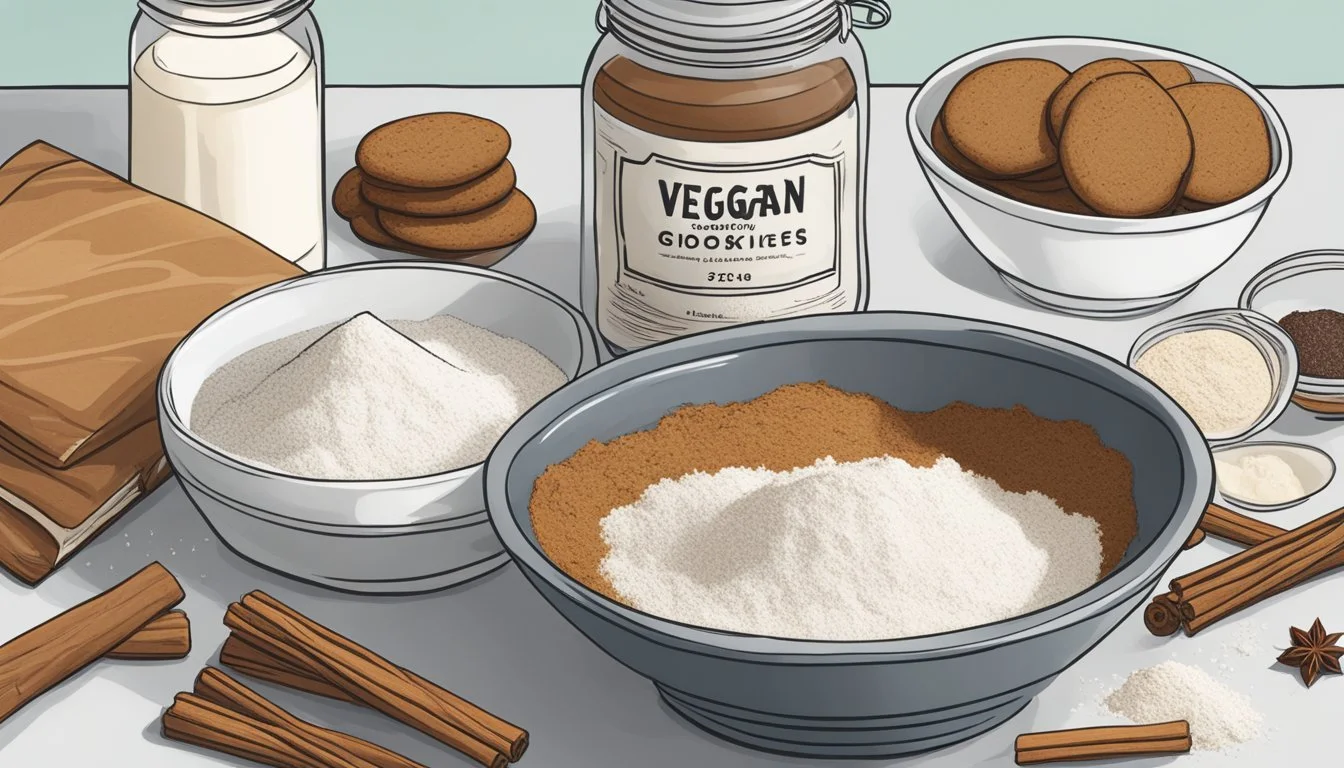Are Gingerbread Cookies Vegan?
Unveiling the Ingredients
Gingerbread cookies, a festive treat commonly associated with holidays and cheerful gatherings, may not initially seem vegan due to traditional recipes that incorporate ingredients like honey, butter, and eggs. However, the versatility of baking allows for various substitutions that can make gingerbread cookies vegan without compromising their characteristic spicy and sweet flavor. Vegan gingerbread cookies make use of plant-based alternatives to replace animal-derived ingredients, providing a cruelty-free option for those adhering to a vegan lifestyle or those with specific dietary restrictions.
The key to veganizing gingerbread cookies lies in the selection of ingredients. For instance, vegan butter or coconut oil can be used instead of dairy butter, and plant-based milk or molasses can serve as suitable replacements for honey. Binding agents such as eggs can be swapped out with flaxseed meal or other egg substitutes. These modifications ensure that the cookies retain the desired texture and cohesion. Furthermore, spices like ginger, cinnamon, and nutmeg – essential for the classic gingerbread flavor – are naturally vegan, making them a staple in both traditional and vegan recipes.
Vegan cookies can be as enjoyable as their non-vegan counterparts, with the added benefit of being more inclusive to those with dietary choices or requirements. With the increasing availability of vegan baking ingredients, making vegan gingerbread cookies is as straightforward as their traditional versions. This adaptability allows everyone to partake in the joy of baking and savoring gingerbread cookies, regardless of dietary preferences.
Understanding Vegan Baking
When baking vegan cookies, including gingerbread, it is essential to use ingredients that are plant-based and to understand the suitable substitutes for traditional, non-vegan items.
Definition of Vegan Ingredients
In vegan baking, every ingredient used must be derived from plants, avoiding all animal products like dairy, eggs, and honey. Vegan butter is a key ingredient that often replaces traditional dairy butter in recipes to create a vegan dough. Vegan butter is typically made from oils such as coconut, soy, or palm oil. Ingredients like flour and molasses are inherently vegan, with flour serving as the staple building block for cookie dough, and molasses adding the rich, signature flavor to gingerbread.
Common Vegan Substitutes
A variety of plant-based alternatives can be used in vegan baking to replace non-vegan items:
Butter: Regular butter can be effectively substituted with vegan butter or coconut oil to achieve a similar taste and texture.
Eggs: Flaxseeds or chia seeds mixed with water create a "flax egg" or "chia egg," acting as binding agents in the dough.
Milk: Plant-based milks such as almond, soy, or oat milk replace cow's milk to add moisture.
Sweeteners: To avoid honey, vegans can use molasses, maple syrup, or agave nectar as sweetening agents.
In conclusion, vegan bakers have a wealth of options at their disposal to craft delicious baked goods that align with their ethical and dietary choices.
Gingerbread Cookie Ingredients
Traditional gingerbread cookies are made with a blend of spices, sweeteners, and fats that combine to create their iconic taste and texture. Understanding the function of these ingredients and the alternatives available is crucial for adapting the recipe to a vegan diet.
Role of Each Ingredient
Flour: Serves as the structure of the cookie, providing a base for other ingredients to mix into.
Ground Ginger & Cinnamon: These spices are essential for the signature flavor of gingerbread.
Baking Soda: Acts as a leavening agent to help the dough rise and provide a lighter texture.
Brown Sugar & Molasses: Contribute to the rich, sweet flavor typical of gingerbread cookies and also offer color and moisture.
Butter: Adds to the richness and helps create a tender crumb in the dough.
Egg: Binds the dough and helps in leavening.
Salt: Balances the sweetness and enhances the overall flavor.
Vegan Alternatives for Common Ingredients
Non-Vegan Ingredient Vegan Alternative Purpose in Recipe Butter Vegan butter or coconut oil Adds richness and helps with the cookie's texture Brown Sugar Unrefined brown sugar or organic brown sugar Offers sweetness and keeps the integrity of the traditional flavor Egg Flax egg (flaxseed meal combined with water) Binds the dough similarly to regular eggs Molasses Unsulphured molasses Provides sweetness and the classic dark color, generally vegan
In vegan gingerbread recipes, vegan butter is often creamed with brown sugar to incorporate air and assist in leavening. The flax egg is used as a binder in place of chicken eggs. Spices like ground ginger, cinnamon, and sometimes ground cloves, along with baking soda, are homogeneously mixed into the flour, forming the dry ingredients. Wet and dry mixes are then combined to form a dough. The role of coconut oil, when used, is similar to that of vegan butter, offering a fatty base for the dough. Salt is added for flavor enhancement, and unsulphured molasses lends traditional color and sweetness.
The Baking Process
The creation of vegan gingerbread cookies from scratch involves meticulously combining ingredients, shaping the cookies, and baking them to perfection. This section unpacks each step to shed light on the detailed artistry behind these delightful treats.
Preparing the Dough
Firstly, chefs preheat the oven to 350°F (180°C), a crucial step for consistent baking. They gather vegan butter – ensuring it is at room temperature for optimal mixing – and combine it with brown sugar using an electric mixer until it achieves a creamy consistency. In a separate bowl, ingredients like flour, baking powder, ground ginger, cinnamon, nutmeg, and cloves are sifted and mixed. This dry mixture is then slowly incorporated into the wet ingredients to form the dough.
Shaping the Cookies
Once the dough is ready, it’s rolled out on a flat surface to a uniform thickness using a rolling pin. Here, precision is key so the cookies bake evenly. Cookie enthusiasts then wield cookie cutters in various shapes to stamp out the cookies. They carefully transfer these shapes onto a baking sheet lined with parchment paper to prevent sticking.
Baking and Cooling
The cookies are then placed in the preheated oven to bake. The typical baking time ranges from 10 to 12 minutes, or until the cookies are golden brown around the edges. It's important not to overbake to maintain the cookies’ characteristic moist center. After baking, they rest on the sheet for a few minutes to firm up. To finish, bakers transfer the gingerbread cookies to a cooling rack where they fully cool down before any frosting is applied, ensuring a crisp, yet tender, texture.
Decorating Gingerbread Cookies
Decorating gingerbread cookies gives individuals the chance to express creativity, especially when using vegan-friendly ingredients. The process involves making vegan icing, often with alternatives to traditional egg whites, and applying various techniques for a festive look.
Making Vegan Icing
For vegan icing, the primary substitute is a combination of powdered sugar, water, and vanilla extract to replace egg whites typically found in royal icing. Here is a simple recipe for vegan icing:
Ingredients:
2 cups powdered sugar
2-3 tablespoons water (or as needed for consistency)
1/2 teaspoon vanilla extract (optional for flavor)
Instructions:
Sift the powdered sugar to avoid lumps.
Gradually add water, stirring until smooth.
Mix in the vanilla extract.
If a thicker consistency is required, add more powdered sugar.
This icing can be used in a piping bag with various nozzle tips to create fine lines, borders, and intricate designs on cookies.
Creative Decorating Techniques
Once the icing is prepared, it's time to embark on decorating, which can range from simple to intricate designs. Sprinkles and colored sugars add a pop of color and texture, while piped icing allows for detailed patterns. Here are some techniques:
Piping: Create borders and details with a fine tip. Practice on parchment paper before applying to cookies.
Flooding: Fill larger areas with a thin layer of icing using a broader tip or a spoon, spreading it to the edges of piped borders.
Marbling: Drag a toothpick through freshly piped contrasting colors of icing to create a marbled effect.
Decorators should be mindful that vegan frosting sets differently and they may need to adjust their technique as they work. For example, a bit more patience may be required for the icing to set before adding layers of decoration.
Storing and Serving
Proper storage ensures that vegan gingerbread cookies maintain their delicious quality, while thoughtful serving suggestions can enhance the holiday experience.
How to Store Vegan Cookies
Vegan gingerbread cookies are best preserved in an airtight container to keep them fresh. If stored at room temperature, they can last up to a week. For longer storage, one may tightly wrap and freeze the cookies for up to three months. To prevent flavors from mingling, ensure they are separated from foods with strong odors in both the pantry and the freezer.
Room Temperature: Store in airtight containers for up to 7 days.
Freezer: Wrap and freeze for up to 3 months.
Serving Suggestions
To serve, allow cookies from the freezer to thaw at room temperature before presenting. Vegan gingerbread men and other festive shapes make delightful additions to Christmas dessert tables. Serve them as stand-alone treats or alongside plant-based milk or warm cider for added holiday cheer.
Room Temperature Thawing: Thaw before serving if previously frozen.
Holiday Presentation: Arrange on a festive platter for enjoyment.
Nutritional Information
Traditional gingerbread cookies are made with ingredients such as flour, butter, egg, and sugar, which contribute to the nutrition profile of the cookies. However, when gingerbread cookies are made vegan, certain ingredients are substituted to avoid animal products, which can alter their nutritional content.
A single medium-sized vegan gingerbread cookie, weighing about 20 grams, may contain the following estimated nutritional values:
Calories: 80-100 kcal
Protein: 1-2 g
Total Fat: 2-4 g
Saturated Fat: 0.5-1.5 g
Total Carbohydrates: 12-16 g
Fiber: 0.5-1 g
Sugar: 5-8 g
Sodium: 90-150 mg
Iron: 0.7-1.2 mg
Calcium: 10-15 mg
Potassium: 40-60 mg
Vitamin A: Generally minimal or not present
Vegan gingerbread cookies typically use plant-based substitutes such as vegan butter, flaxseed or chia eggs, and plant-based milk, which influence the nutritional content. Vegan butter may decrease the saturated fat content compared to regular butter. Flaxseeds used as an egg substitute add fiber and omega-3 fatty acids. Using whole wheat flour instead of white flour can also increase the fiber content.
It should be noted that variations in recipes will cause nutritional content to vary. The inclusion of ingredients like molasses, which is high in iron and calcium, can enhance the nutritional profile of vegan gingerbread cookies. On the other hand, the use of refined sugar contributes to the total sugar content. Consumers should look for recipes that use natural sweeteners and nutrient-dense ingredients for a healthier version.
These general nutritional guidelines help consumers understand what to expect from vegan gingerbread cookies, but the actual values can differ based on the recipe and the size of the cookie.
Special Dietary Considerations
When adapting gingerbread cookies for those following a vegan diet, one must also consider individuals with gluten sensitivities or celiac disease. These dietary restrictions require substituting common ingredients found in traditional gingerbread cookie recipes to accommodate their specific dietary needs while ensuring the final product remains enjoyable and structurally sound.
Gluten-Free Vegan Gingerbread Cookies
Traditional gingerbread cookies often call for all-purpose flour, a source of gluten that provides structure and elasticity to the cookies. For a gluten-free vegan alternative, one can replace all-purpose flour with a gluten-free flour blend. These blends typically include a mix of rice flour, potato starch, and tapioca flour, which mimic the properties of gluten, providing the necessary carbohydrates without the gluten protein that causes adverse reactions in some individuals.
It is important to measure gluten-free flour accurately, as it can alter the texture if used in incorrect proportions. A common ratio for substituting gluten-free flour for all-purpose flour is 1:1, but since gluten-free flours absorb more moisture, additional liquid may be needed in the recipe. Here is an example of how to approach the flour substitution:
All-Purpose Flour: 1 cup
Gluten-Free Flour Blend: 1 cup (check packaging for specific blend ratio)
When baking gluten-free vegan gingerbread cookies, one should be mindful that the resulting dough may be more fragile than its gluten-containing counterpart. The baker might need to handle the dough with care, as gluten-free dough can crack or break more easily. To prevent this, bakers often refrigerate the dough before rolling and cutting it into shapes. Additionally, xanthan gum is sometimes added to gluten-free baking recipes to improve the texture and elasticity of the dough.







